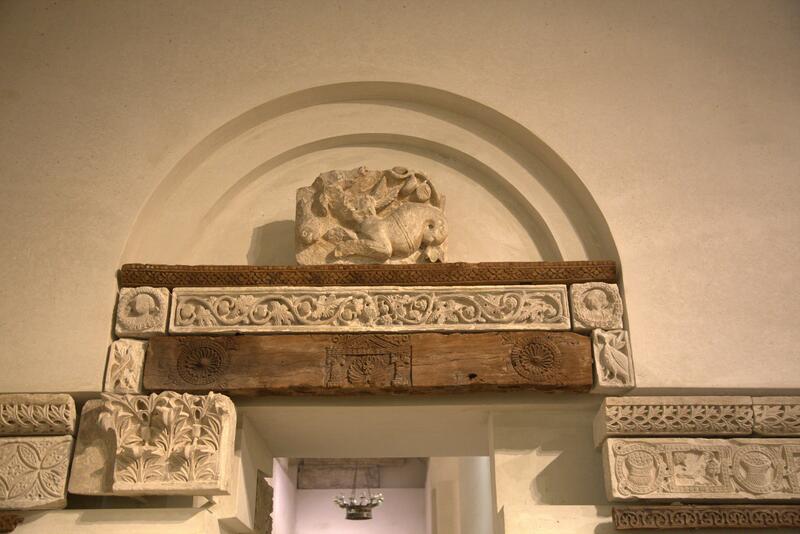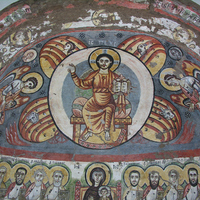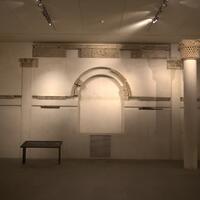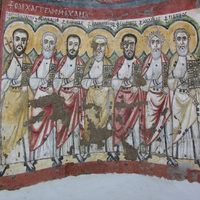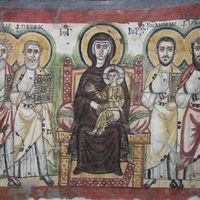Wall paintings from Bawit
Type:
Capitals,
Chapels,
Churches,
Monasteries,
Secular architecture,
Sculptures,
Tombs,
Wall paintings
Date:
Late fourth to eleventh century
Location or Findspot (Modern-Day Country):
Egypt
Dimensions:
Apse of Room 6, H 220 cm, W 170 cm
Description:
Bawit was the site of a monastery founded by Apa Apollo in the late fourth century. The site grew to include multiple monastic complexes, used until the eleventh century. Three basilica churches have been found, with walls of baked brick clad in limestone and ornamented with carved capitals and friezes in stone and wood, including some spolia, as well as traces of wall paintings. A khurus was added to the north church after the seventh century. In addition to larger halls with painted niches, there are numerous smaller chapels, residential buildings and kitchens, workshops, and tombs for the monks. Over 150 buildings have been identified, even though only 10 percent of the site has been excavated. The south church has been reconstructed in the Louvre Museum in Paris.
The brightly painted niches (executed in tempera, not fresco) are reminiscent of the slightly earlier paintings in the Red Monastery, not far to the south. They are usually divided into two horizontal registers, with Christ on the top and Mary in the lower zone, to emphasize Christ's fully divine and human aspects in accord with the Miaphysite position..
The best-known apse, from Room 6 (now preserved in the Coptic Museum in Cairo, inv. no. 7118), has Christ enthroned in majesty in the conch, surrounded by evangelist symbols—the heads are nestled among the many-eyed cherubim of Ezekiel 10 and Revelation 4—and flanked by archangels and personifications of day and night; all the figures are labeled in Greek. In the lower zone, two local Egyptian saints are included among the standing apostles. The molding around the apse depicts personified busts of the gifts of the Holy Spirit, such as Mercy, Virginity, and Patience. The apse paintings date to the sixth or seventh century.
In addition to Christian iconography, Bawit also has paintings of Old Testament scenes, personified Virtues, hunting scenes, and geometric decoration. About two dozen inscriptions record the names of painters or plasterers active between about 500 and 800.
The brightly painted niches (executed in tempera, not fresco) are reminiscent of the slightly earlier paintings in the Red Monastery, not far to the south. They are usually divided into two horizontal registers, with Christ on the top and Mary in the lower zone, to emphasize Christ's fully divine and human aspects in accord with the Miaphysite position..
The best-known apse, from Room 6 (now preserved in the Coptic Museum in Cairo, inv. no. 7118), has Christ enthroned in majesty in the conch, surrounded by evangelist symbols—the heads are nestled among the many-eyed cherubim of Ezekiel 10 and Revelation 4—and flanked by archangels and personifications of day and night; all the figures are labeled in Greek. In the lower zone, two local Egyptian saints are included among the standing apostles. The molding around the apse depicts personified busts of the gifts of the Holy Spirit, such as Mercy, Virginity, and Patience. The apse paintings date to the sixth or seventh century.
In addition to Christian iconography, Bawit also has paintings of Old Testament scenes, personified Virtues, hunting scenes, and geometric decoration. About two dozen inscriptions record the names of painters or plasterers active between about 500 and 800.
Relevant Textbook Chapter(s):
2,
3,
4
Repository and Online Resources:
• Read about the Bawit excavations on the website of the Institut française d'archeologic orientale.
Image Credits:
Elizabeth Bolman; Heather A. Badamo; Linda Safran
